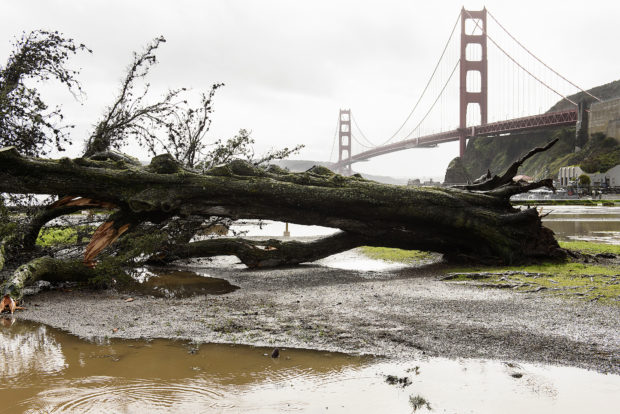
A fallen tree that was knocked down by recent severe weather lies in the Horseshoe Bay parking lot in front of the Golden Gate Bridge in Sausalito, Calif., Thursday, Feb. 14, 2019. Waves of heavy rain pounded California on Thursday, filling normally dry creeks and rivers with muddy torrents, flooding roadways and forcing residents to flee their homes in communities scorched by wildfires. (AP Photo/Michael Short)
SAUSALITO, Calif.— Authorities warn that mudslides are still possible Friday even after a damaging storm moved through California, trapping people in floodwaters, triggering a debris flow that destroyed homes, and forcing residents to flee communities scorched by wildfires last year.
The powerful system swept in from the Pacific Ocean and unleashed rain, snow and wind across the U.S. West into Wyoming and Colorado after walloping Northern California and southern Oregon earlier.
The rain mostly ended Thursday night. But officials said hillsides could still loosen and collapse, bringing down mud, boulders and debris.
“The ground is still so saturated and the water is still flowing down from the mountains,” said April Newman, spokeswoman for Riverside County Fire Department.
The National Weather Service reported staggering rainfall amounts across California, including more than 9.4 inches (24 centimeters) over 48 hours at one location in the San Bernardino Mountains east of Los Angeles.
A woman pulled from rising water in a low-lying area between those mountains and Los Angeles had a heart attack and died at a hospital, said Capt. Ryan Rolston with the Corona Fire Department. The unidentified woman was one of nine people and three dogs rescued in a flood-control channel where homeless people camp, Rolston said.
A second death was reported in Escondido, northeast of San Diego, where firefighters recovered the body of a man who had been seen paddle boarding in the surging waters of a concrete-lined flood-control channel.
North of San Francisco, a mudslide barreled over cars, uprooted trees and sent a home sliding down a hill and smashing into another house in Sausalito.
A woman was rescued from the splintered wreckage with only cuts and bruises. Susan Gordon was buried under a tree and mud for two hours while crews dug her out, her son wrote on an online fundraising page.
Chris Parkman said it has been years since a storm so powerful has hit the hillside community, where at least 50 properties were evacuated.
“We don’t see the rain most of the year. So most of the year you feel safe. But when the big storms come, your safety factor is gone,” he said.
Further north, a levee along State Route 37 near Novato was breached, flooding a rural field. Officials were monitoring the area in case water flows onto the highway or train tracks.
A deluge southeast of Los Angeles washed away a section of a two-lane mountain highway. Photos by the state Department of Transportation showed about 75 feet (23 meters) of pavement completely collapsed along State Route 243 near the remote community of Idyllwild.
“We’re basically stranded right now,” said resident Gary Agner, adding that several other roads were closed because of flooding and debris. “I’m glad I went to the grocery store yesterday.”
The risk of flooding led officials to order people out of areas burned bare by a summer wildfire in the Santa Ana Mountains, with flash-flood warnings blanketing a huge swath east and south of Los Angeles. The evacuation orders were downgraded to flood warnings Thursday night.
Authorities also told parts of artsy Laguna Beach to evacuate for much of the day, while the desert resort city of Palm Springs urged residents to stay where they were because of flooded streets. Flood advisories extended to Arizona.
Weather was so severe that the Hollywood Walk of Fame had to postpone the dedication of a sidewalk star honoring the band Aerosmith. Knott’s Berry Farm and Six Flags Magic Mountain theme parks closed.
Trouble also persisted in saturated Northern California, where thousands of people lost power and flooding was possible. Downtown San Francisco saw more than 1.75 inches (4.4 centimeters) of rain over 24 hours.
A flooded creek led authorities to urge about 300 residents to leave a community about 20 miles (32 kilometers) west of Paradise, a town destroyed last year by the nation’s deadliest wildfire in a century.
The storm followed more than a week of severe weather in the Pacific Northwest and was the latest in a series of storms that has all but eliminated drought-level dryness in California this winter. It’s fueled by an atmospheric river — a plume of moisture stretching across the Pacific Ocean nearly to Hawaii.
Nearly 37 percent of California had no level of drought or abnormal dryness, the U.S. Drought Monitor reported Thursday. About 10.5 percent of the state was in moderate drought, and just over 1.6 percent was in severe drought. The remainder was in the abnormally dry category. The numbers reflect data gathered up to Tuesday.
Atmospheric rivers are long bands of water vapor that form over an ocean and flow through the sky. Formed by winds associated with storms, they occur globally but are especially significant on the West Coast.
Even before the height of the storm, mandatory evacuations were ordered near the wildfire area in the Santa Ana Mountains where officials said there was a high risk of debris flows. /gsg